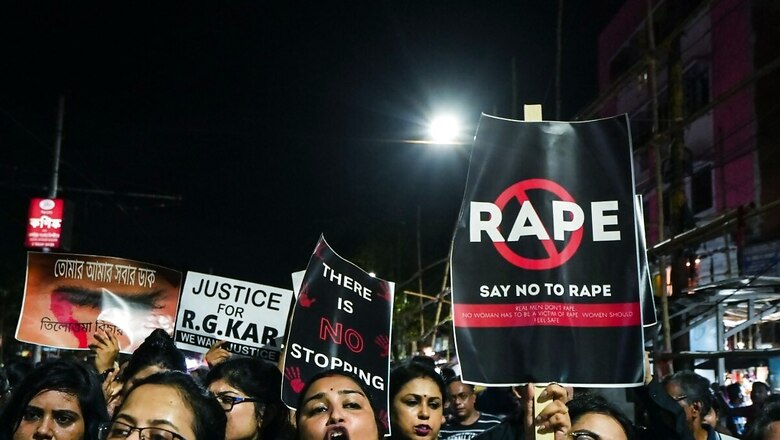
views
The unprecedented scenes that played out in West Bengal throughout Sunday night was than just an outpouring of solidarity with the parents of the raped and murdered woman doctor of RG Kar Medical College. The people on the streets across the state were reclaiming more than just the night, they were calling time on a benighted administration and the pall of darkness epitomised by the brazen crime within the precincts of a hospital in the heart of Kolkata.
The slogans and songs not only demanded justice for the doctor but also a change in the way things had been functioning in the state, an end to collusion and extortion. The people on the streets were not recognisable political faces, nor were they the types whom the Trinamool Congress and Chief Minister Mamata Banerjee hitherto loved to characterise as either ‘Ram-Baam’ (BJP and CPIM) or as motivated outsiders, troublemakers, communalists, disrupters.
Whether looking around while on the streets or simply watching them on TV from the comfort of their homes, no one could be left in doubt that those protesting even a month after the gruesome death of the doctor were very ordinary people, concerned citizens cutting across age and social standing. Especially women, oh so many women—the huge constituency that supposedly stands solidly by the state’s woman CM. That assertion now stands conclusively belied.
Plump matrons in cotton sarees and hair rightly rolled in buns stood (or marched) arm in arm with girls in trousers or salwar-kameez, not looking remotely like political storm troopers no matter how much Trinamool Congress social media handles tried to posit them as crypto-saffronites. They defied the conventional wisdom that years of state-funded stipends via Lokkhir Bhandar and Kanyashree Scheme had suppressed their souls and killed their consciences.
Every female heart in Bengal must have filled with rage at the innumerable instances of rape-murder cases going either unrecorded, being hushed up—or investigations deliberately botched up so that they are dismissed by the courts. But so far, these women had not been able to voice that anger and frustration due to the pervasive fear of lakhs of Sanjay Roy type of goons who permeated all institutions of the state and intimidated people into staying mum.
This enforced silence was passed off as evidence that they—particularly women—remained supporters of the state administration and their CM. The fear factor was hidden behind the façade of generous official largesse, giving the impression that the common people were okay with the way the state was being run as long as they got their free provisions, stipends and donations for the local Durga Puja celebrations. Sunday night showed that is not the case.
The beleaguered West Bengal government is now trying to shift the narrative once again now that the “public support” myth has been busted. First it is voicing increasing concern about the “inconvenience” of the people with government doctors still on the streets protesting. Kapil Sibal, the state’s advocate, telling the Supreme Court Chief Justice-led Bench on Monday that 24 people have allegedly died due to the continued doctors’ stir is part of this changed strategy.
The CM’s favourite nephew and powerful Lok Sabha MP Abhishek Banerjee also took up the cudgels on behalf of one such victim who allegedly bled to death because there were no doctors to treat him. The intent is clear: attempting the fourth part of the ancient Kautilyan tactic of Sama, Daam, Dand, Bhed (conciliation, bribery, punishment and fomenting discord) advised by in the Arthashastra to deal with intractable problems. That too has not worked.
Sibal and junior Banerjee gloss over the fact that the people are not voicing anti-doctor sentiments at all in a state infamous for families of patients vandalising hospitals and assaulting duty doctors because of alleged negligence. The sheer brutality and brazenness of the rape-murder of the doctor right inside the premises of her college has apparently changed people’s mindsets and attitudes from August 9. Even Banerjee has been taken aback by this sudden reversal.
But Sunday night’s crowds on the streets—including women of all ages—was probably the most unpleasant surprise of all for the CM, as it indicates that the fear that kept the state under control has dissipated. Even two months ago, apolitical demonstrations of this kind would have been unimaginable. No one in their right minds would have dared to take on the ruling party’s goons who had become the bosses of localities, entrusted with keeping people in line.
For decades, starting with the 34 years of Left Front rule—the only protests in Bengal were union-led bandhs, marches and demonstrations or those by political parties, comprising party workers. Non-politically active people were mostly absent. This time, it is the opposite as opposition parties have stayed away from the forefront of the protests and Banerjee’s own attempt to appropriate the popular sentiment by leading a march herself was surprisingly unsuccessful.
Surprising because she had tried the same tactic before and got the results she wanted. Banerjee had managed so far to keep up the image that she was the only person that the people of West Bengal saw as their saviour. She had also disrupted earlier opposition party marches by sending in mobs who vandalised public property on the route, giving her government a chance to brand protests as violent and “anti-people”. So she tried that at RG Kar on August 14 too.
She failed to quell the protest by that early show of brute force. But she tried again for the next few days, with the police clashing with people at a cancelled football match, and then using teargas and water cannon on marchers heading to the state government headquarters at Nabanna. Both did not deter the protest—it had quite the opposite effect on the people, and considerably dented the CM’s image as being on the side of speedy justice and, indeed, anti-corruption.
Now she has dropped the ‘dand’ option at least when it comes to the general body of people. The Kolkata Police have put away their lathis and aggressive assertions by even the Commissioner of Police—whom protestors want removed—have ceased. However, prominent personalities emboldened to join protests because of civil society’s broad sympathy with the cause of justice and rooting out corruption have been cautioned by those sympathetic to the ruling dispensation.
Every day protests continue, that fear will dissipate further, which may impact what happens in 2026, or earlier. The ruling party will try to dispense with the rape-murder case fast and posit that as the fulfilment of the protesters’ demands. Banerjee will also hope the probe into the murky goings-on at RG Kar—seen as emblematic of the corruption across institutions and governance—can somehow be stalled. But the people on the street may not play ball this time.
The author is a freelance writer. Views expressed in the above piece are personal and solely those of the author. They do not necessarily reflect News18’s views.


















Comments
0 comment